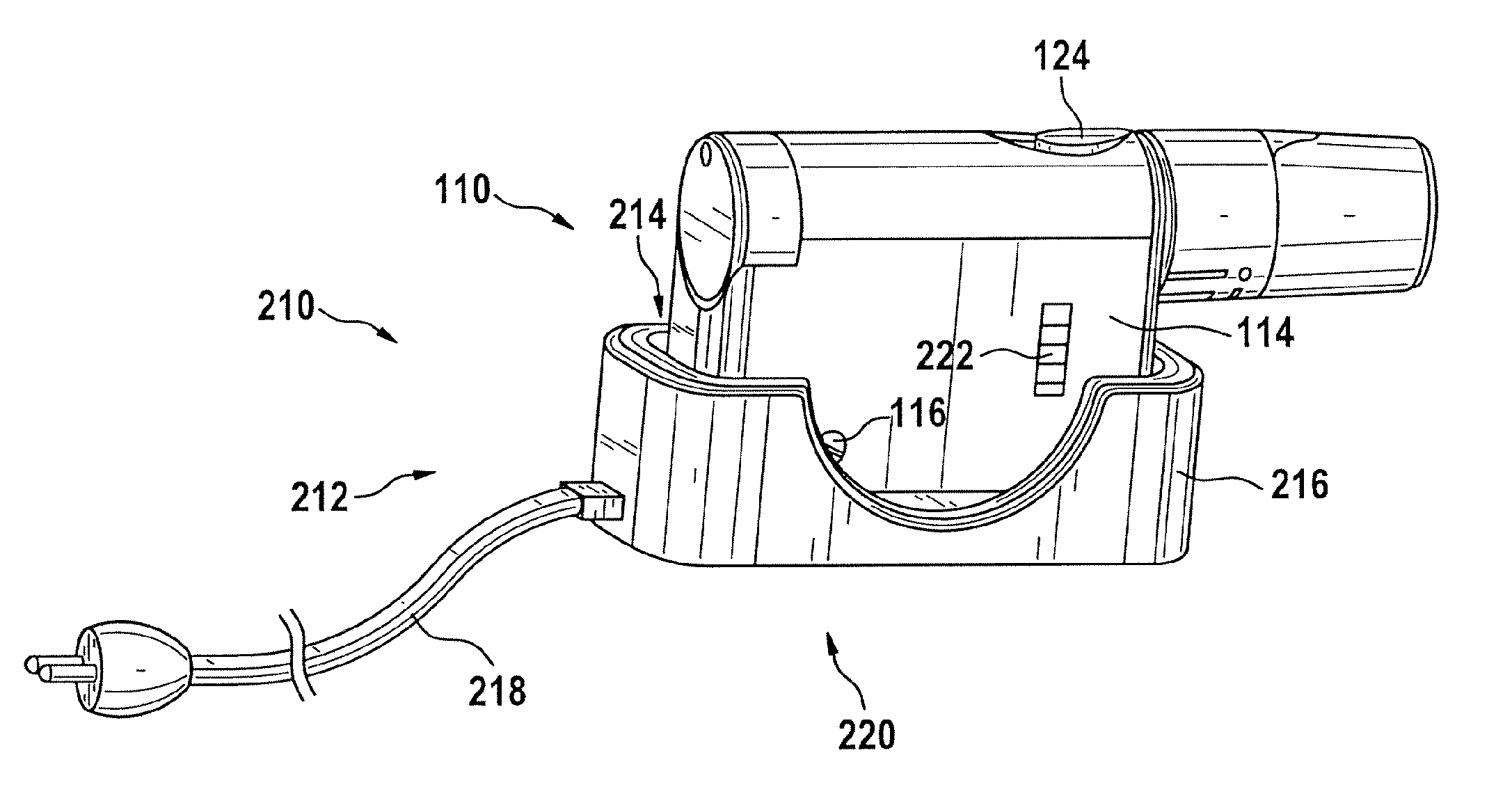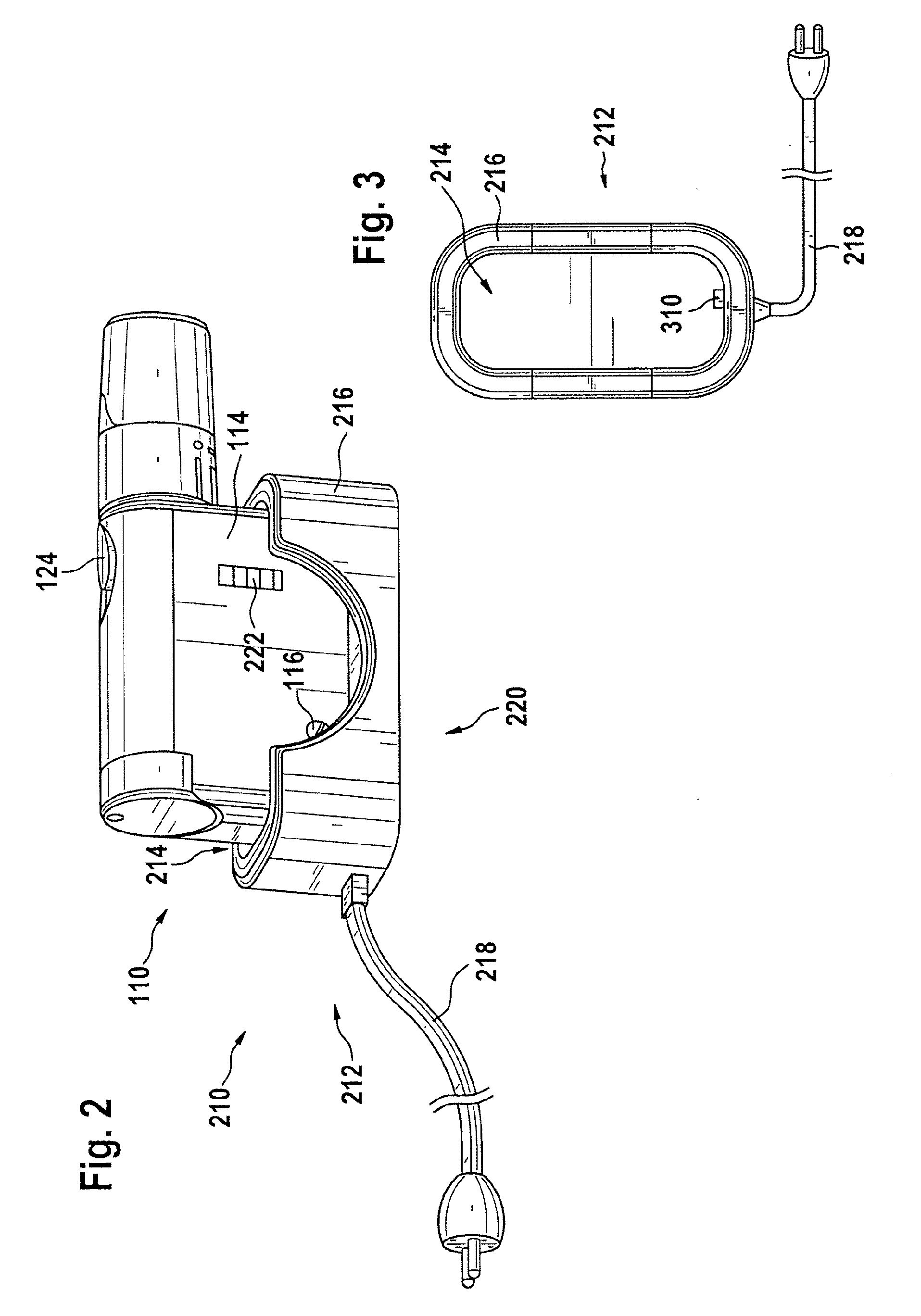[0010] In addition, one embodiment of the portable lancing aid has at least one rechargeable long-term
energy source that is connected to the electromechanical
actuator in order to store electrical energy. In this embodiment, the energy source is used for storing electrical energy and remains substantially charged even after days if there is no
electrical load. In particular, the electrical energy or charge should not decrease below 40% of the original energy or charge within about three days. This long-term energy source can be a battery and it has proven to be advantageous in various embodiments to use rechargeable batteries such as rechargeable
lithium ion batteries and / or rechargeable
lithium polymer batteries. It is also possible to use rechargeable
nickel cadmium batteries and / or rechargeable
nickel metal hydride batteries (NimH). However, it is also possible to use other types of rechargeable batteries. Thus, for example, capacitors having a long-term
storage effect such as “supercaps” (also referred to as ultra capacitors) can also be used. Stored electrical energy can also be partially removed from these supercaps similar to batteries or rechargeable batteries and the self-
discharge of these components is very low. Typical supercaps still have about 60-70% of their original charge after 30 days without load. Such components have the particular
advantage over conventional rechargeable batteries in that they can be rapidly charged.
[0011] In another embodiment, the portable lancing aid has at least one interface that is accessible from outside the lancet system, wherein the long-term energy source can be connected to the interface in order to store electrical energy and be recharged. This interface can be one or more electrodes, such as
metal electrodes, which are arranged on the outside of the housing. An appropriate complementary interface (e.g., a charging interface or
charging station) can then be used to
supply energy to these
metal electrodes via connection to an appropriate
power supply unit. This allows the energy source of the portable lancing aid to be recharged at regular intervals.
[0013] The charging operation can take place when a charge level indicator shows that the charge level is below the minimum charge value for the long-term energy source. Hence, it has proven to be advantageous in one embodiment when the portable lancing aid has a charge level indicator to display the electrical charge level of the energy source for storing electrical energy. Such charge level indicators are known to a person skilled in the art and can, for example, have simple optical displays and / or acoustic indicators. In particular, the charge level indicator can have an optical segment display in the form of one or more light-emitting diodes which indicate the charge level of the energy source. Furthermore, the user of the portable lancing aid can also be given a warning such as an alarm such as an optical or acoustic
signal when the charge level of the energy source reaches or falls below a specified minimum charge level. Thus, the user can be warned when the charge level of the energy source is no longer adequate to tension the lancet system or when the charge level is only sufficient for a few tensioning operations (for example, enough energy for a daily number of blood glucose measurements). This prevents the user or patient from not being able to carry out blood glucose measurements due to an unexpectedly uncharged energy source of the portable lancing device.
[0014] Embodiments of the portable lancing aid are advantageous over lancing aids in the prior art because the user no longer has to exert any
mechanical force to tension the lancet system. The lancet system is instead tensioned by the electromechanical
actuator. Hence, the portable lancing aid can also be used comfortably by patients with
physical limitations or by children. The portable lancing aid can also be easily operated with one hand. If the charge level of the energy source and, in particular of the rechargeable battery, falls below a specified minimum value, the user or patient is warned accordingly so that the energy source can either be recharged or replaced. In addition, an embodiment of the device can also be provided in which the tensioning device is manually tensioned so that the lancet system can still be tensioned even when the energy source is empty or almost empty, but in this case the patient has to exert a
mechanical force.
[0015] In an exemplary embodiment, the portable lancing aid can include at least one tensioning status sensor which detects the tensioning state of the tensioning device. Furthermore, means can be provided such as an appropriate electronic device or element (e.g., a
microcomputer or other electronic components) to analyze the detected state of tension of the tensioning device. A tensioning operation can then be triggered depending on the detected state of tension. If it is, for example., found that the lancet system is in an untensioned state (e.g., after the lancet system has been triggered), the tensioning device can be automatically retensioned. The portable lancing aid is thus again ready for operation and further intervention by the user is not necessary. This embodiment is especially advantageous in combination with a portable lancing aid having a
magazine for holding a plurality of lancets. In this embodiment, the system is designed such that a new lancet is selected automatically for each tensioning operation and prevents unhygienic
multiple use of the same lancet. In an alternative embodiment, the lancet can be selected manually by the user, for example, by means of an appropriate rotary knob connected to the
magazine.
[0017] The
charging station can, for example, have at least one charging interface or
coupling which can be connected to a source of electrical energy. This connection can be via one or more switches (for example selection switches or on / off switches) or via an
electronic circuit so that an appropriate
voltage transformation, an
overvoltage protection, and / or an appropriate interval
timer can be used which simplifies the handling of the system and makes a
safer design. In this embodiment, it should be possible to connect the portable lancing aid to the charging
station such that the charging interface or
coupling is connected to the interface of the portable lancing aid. This connection between the portable lancing aid and the charging
station can be accomplished by inserting the portable lancing aid into a corresponding recess of the charging
station where the portable lancing aid is advantageously aligned during
insertion such that the interface of the portable lancing aid is in electrical contact with the interface or
coupling of the charging station.
 Login to View More
Login to View More  Login to View More
Login to View More 


